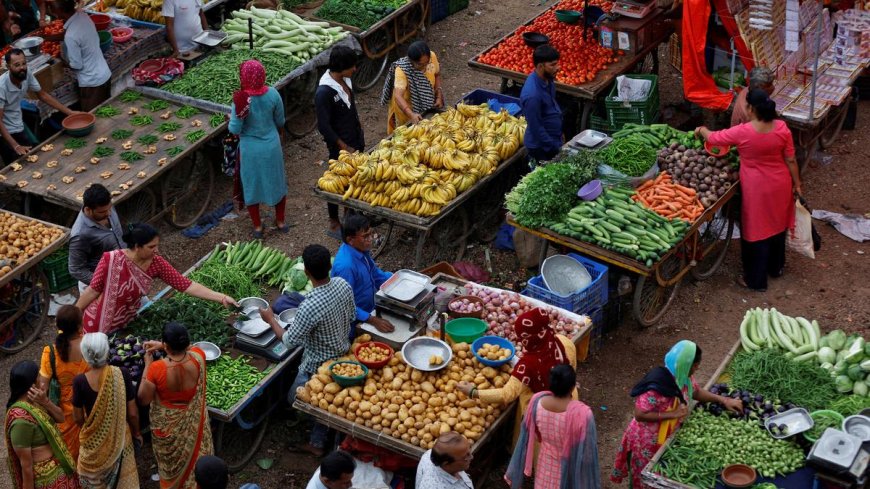Retail inflation declines to six-year low of 3.16% in April: Government data

Asarkari - Sarkari News, Jobs & Updates
Retail inflation declines to six-year low of 3.16% in April: Government data
kam sabdo me kahein to, retail inflation based on the Consumer Price Index (CPI) for April has reportedly touched a significant six-year low of 3.16 percent, primarily driven by a substantial easing in food prices, according to recent government data. This development brings a wave of relief for household budgets across the nation.
By Meera Krishnan
A Welcome Respite: Inflation Eases Significantly
In a much-anticipated economic update, the latest figures released by the National Statistical Office (NSO), under the Ministry of Statistics and Programme Implementation, reveal a noteworthy downturn in the pace of retail inflation. The Consumer Price Index (CPI)-based inflation for the month of April stood at 3.16 percent. This marks the lowest level recorded in six years for this particular month, signalling a period of eased price pressures for the average Indian consumer. This figure is a significant indicator of the nation's economic health, watched closely by policymakers, businesses, and citizens alike.
The decline is a continuation of a moderating trend observed in recent times, offering a breather from the persistent concerns over rising living costs. The data suggests that measures to control price rise, coupled with favourable base effects and improved supply chains for certain commodities, might be yielding positive results.
Decoding the Numbers: What Drove Inflation Down?
The primary catalyst behind this encouraging dip in retail inflation appears to be the food basket. Inflation in the Consumer Food Price Index (CFPI) saw a marked deceleration. Specifically, prices of vegetables, fruits, and pulses, which often contribute significantly to household expenditure, have shown a softening trend. This moderation in food prices is crucial as it directly impacts the day-to-day expenses of millions.
Beyond food, core inflation, which excludes the volatile components of food and fuel, also reportedly remained stable or showed a slight easing. This indicates that underlying price pressures in the economy are, for now, contained. Fuel and light inflation, another key component, also played its part, though global crude oil prices remain a key variable to monitor in the coming months. The consistent efforts to manage supply-side constraints and the impact of previous monetary policy actions are likely contributing factors to this overall subdued inflation scenario. For more updates on economic indicators and sarkari schemes, visit https://asarkari.com.
Implications for the Economy and the Common Citizen
This decline in retail inflation carries several positive implications. For the Reserve Bank of India (RBI), lower inflation provides more headroom to calibrate its monetary policy. With inflation staying within the RBI's comfort zone (target range of 2-6 percent), it could influence future decisions regarding interest rates, potentially creating a more conducive environment for economic growth and investment.
For the common citizen, the most immediate benefit is relief from the burden of escalating prices. Lower inflation means that the purchasing power of money erodes at a slower rate, allowing households to manage their budgets more effectively and possibly save more. This is particularly beneficial for those in fixed-income groups and the economically vulnerable sections of society.
Businesses, too, can benefit from a stable price environment. Predictable inflation reduces uncertainty, making it easier for companies to plan investments, manage costs, and set prices. This can foster a more stable operational landscape, potentially leading to increased production and job creation in the medium term.
Asarkari’s Analysis: A Deeper Look at the Trends
Team Asarkari views this development with cautious optimism. While the headline inflation number is indeed encouraging, it's essential to dissect the sustainability of this trend. The current low food inflation, for instance, is partly attributable to a good rabi harvest and efficient supply management. However, the upcoming monsoon season's performance will be critical in determining the trajectory of food prices in the latter half of the year. Any adverse weather conditions could potentially reverse the current gains.
Furthermore, global geopolitical uncertainties and their impact on commodity prices, especially crude oil, remain a persistent risk factor. A sharp rise in global oil prices could quickly transmit to domestic inflation, undoing some of the current relief. It is also pertinent to consider whether this low inflation is a sign of robust supply meeting demand, or if it also hints at a possible moderation in aggregate demand in certain sectors of the economy. A nuanced understanding requires looking at other high-frequency indicators like industrial production and PMI data.
From a jobs and updates perspective, which is central to Asarkari's mission, stable and low inflation is generally a positive sign. It can encourage businesses to expand and invest, potentially leading to more employment opportunities. Government finances also benefit from controlled inflation, allowing for more fiscal space for developmental and welfare expenditures, including funding for various Sarkari jobs and schemes. However, it's crucial that this low inflation is accompanied by strong economic growth to translate into tangible benefits for job seekers and the broader population.
Looking Ahead: Path to Sustained Price Stability
The April inflation figures offer a moment of cheer, reflecting a significant easing of price pressures. It underscores the resilience of the Indian economy in navigating complex global and domestic challenges. However, the path ahead requires continued vigilance from policymakers. Ensuring that supply chains remain robust, agricultural productivity is enhanced, and global headwinds are effectively managed will be key to sustaining this low inflation environment.
The government and the RBI will need to continue their coordinated efforts to maintain price stability while fostering economic growth. For citizens, this period of lower inflation provides an opportunity to strengthen their financial health. As always, staying informed about economic trends and government policies is crucial for making sound financial decisions.
Team Asarkari
Keywords
Retail inflation India, CPI April data, India inflation rate 3.16%, government inflation statistics, food price decline India, economic news India April, six-year low inflation India, RBI monetary policy outlook, consumer price index India, Asarkari news, Indian economy updatesWhat's Your Reaction?
 Like
0
Like
0
 Dislike
0
Dislike
0
 Love
0
Love
0
 Funny
0
Funny
0
 Angry
0
Angry
0
 Sad
0
Sad
0
 Wow
0
Wow
0








































